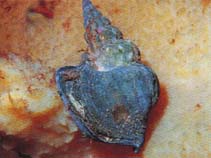Aporrhais occidentalis Beck, 1836
American pelicanfootWarning: DOMDocument::load(): SSL operation failed with code 1. OpenSSL Error messages: error:140770FC:SSL routines:SSL23_GET_SERVER_HELLO:unknown protocol in C:\Apache24\htdocs\includes\SpeciesSummary.lib.php on line 1236
Warning: DOMDocument::load(): Failed to enable crypto in C:\Apache24\htdocs\includes\SpeciesSummary.lib.php on line 1236
Warning: DOMDocument::load(https://sealifebase.nrm.se/webservice/AquaMaps/getAMap.php?genus=Aporrhais&species=occidentalis): failed to open stream: operation failed in C:\Apache24\htdocs\includes\SpeciesSummary.lib.php on line 1236
Warning: DOMDocument::load(): I/O warning : failed to load external entity "https://sealifebase.nrm.se/webservice/AquaMaps/getAMap.php?genus=Aporrhais&species=occidentalis" in C:\Apache24\htdocs\includes\SpeciesSummary.lib.php on line 1236
Classification / Names Common names | Synonyms | CoL | ITIS | WoRMS
| Littorinimorpha | Aporrhaidae
Environment: milieu / climate zone / depth range / distribution range Sinh thái học
; Mức độ sâu 4 - 1829 m (Ref. 83435). Boreal; 67°N - 36°N, 79°E - 56°E (Ref. 83435)
Sự phân bố Các nước | Các khu vực của FAO | Các hệ sinh thái | Những lần xuất hiện | Những chỉ dẫn
Arctic and North America.
Length at first maturity / Bộ gần gũi / Khối lượng (Trọng lượng) / Age
Maturity: Lm ? range ? - ? cm Max length : 7.0 cm DL con đực/không giới tính; (Ref. 83435); common length : 5.1 cm SHL con đực/không giới tính; (Ref. 360)
Short description Hình thái học
Shell: high conical spire, rather thick and solid, with swollen whorls and very impressed sutures; outer lip is broadened and forms a large unfingered expansion; both outer and columellar lips are strongly thickened; sculpture consists of a score of strong well-spaced axial ribs, usually curving, also a spiral ornament of thin, deeply incised grooves, especially marked on the body whorl; whitish cream or grayish in color; the operculum is very small, horny and ellipsoidal, with smooth edges. Body: similar to the strombids, especially in the structure of the long and narrow foot with a smaller anterior lobe and a large posterior one that bears the operculum and enables the mollusk to leap; eyes are not pedunculated, but are at the base of the tentacles; mantle cavity contains only one gill, the osphradium and in males, the copulatory organ; radula is taenioglossan.
Life cycle and mating behavior Chín muồi sinh dục | Sự tái sinh sản | Đẻ trứng | Các trứng | Sự sinh sản | Ấu trùng
Members of the order Neotaenioglossa are mostly gonochoric and broadcast spawners. Life cycle: Embryos develop into planktonic trocophore larvae and later into juvenile veligers before becoming fully grown adults.
Main reference
Các tài liệu tham khảo | Người điều phối | Người cộng tác
Sabelli, B. and H.S. Feinberg (eds.). 1879. (Ref. 360)
IUCN Red List Status (Ref. 130435)
CITES status (Ref. 108899)
Not Evaluated
CMS (Ref. 116361)
Not Evaluated
Threat to humans
Human uses
| FishSource |
Các công cụ
Thêm thông tin
Các nước
Các khu vực của FAO
Các hệ sinh thái
Những lần xuất hiện
Những chỉ dẫn
Stocks
Sinh thái học
Thức ăn
Các loại thức ăn
Các khu vực của FAO
Các hệ sinh thái
Những lần xuất hiện
Những chỉ dẫn
Stocks
Sinh thái học
Thức ăn
Các loại thức ăn
Tên thường gặp
Các synonym ( Các tên trùng)
Các động vật ăn mồi
Sự tái sinh sản
Chín muồi sinh dục
Đẻ trứng
Sự sinh sản
Các trứng
Egg development
Các synonym ( Các tên trùng)
Các động vật ăn mồi
Sự tái sinh sản
Chín muồi sinh dục
Đẻ trứng
Sự sinh sản
Các trứng
Egg development
Các nguồn internet
BHL | BOLD Systems | CISTI | DiscoverLife | FAO(Publication : search) | Fishipedia | GenBank (genome, nucleotide) | GloBI | Gomexsi | Google Books | Google Scholar | Google | PubMed | Cây Đời sống | Wikipedia (Go, tìm) | Tạp chí Zoological Record
Estimates based on models
Price category
(Ref. 80766):
Unknown.



